| “倏忽温风至,因循小暑来。竹喧先觉雨,山暗已闻雷。” 小暑是二十四节气中的第十一个节气,“暑”,热也,“小暑”即为小热,意味着盛夏已经来临。 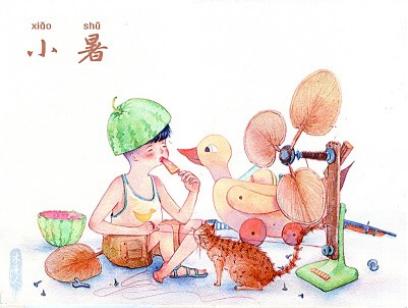 小暑(水彩画)木壳人 正值初伏前后的小暑节气,天气闷热潮湿,插画家木壳人的水彩插画《小暑》中,男孩头顶西瓜皮,俏皮可爱,手工自制的“简易风扇”趣味十足。画家将富有夏日特色的元素,以极具想象力的手法组合在一起,清新的色彩搭配仿佛瞬间驱散了空气中弥漫的热浪。 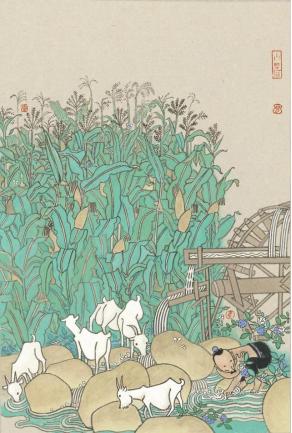 小暑(中国画)刘金贵 而在画家刘金贵看来,一场水中嬉戏也是退热祛暑的好方法。中国画作品《小暑》中,玉米地大面积的绿色为画面铺就了基调,经由水车倾泻而下的清泉在乱石间蜿蜒流淌,点缀其间的人物和山羊姿态各异,与自然景物动静结合,大面积的留白处理更是为作品增添了清凉之感。 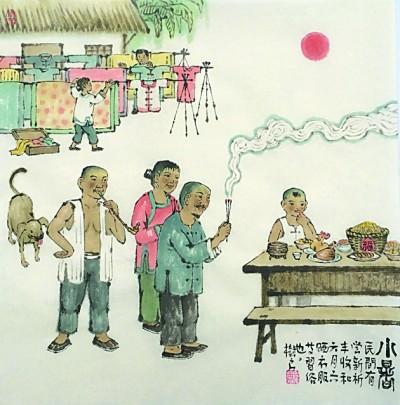 小暑(中国画)戴树良 酷热的天气需要做好防护,也得善加利用。民谚有云:“小暑晒霉正当时”,家家户户多会选择在这一时段晒书画、晾衣服。 画家戴树良的中国画作品《小暑》对此进行了描绘:画面远景中,烈日当空,整齐晾晒的各色衣物和被褥化作斑斓的色块,成为夏日里一道亮丽的风景。 画面前景则描绘了小暑节气的另一习俗——“食新”,就是品尝新米。 在农村,农民将新割的稻谷碾成米后,做好饭供祀五谷大神和祖先,然后人人吃尝新酒。 而在城市,人们一般会买来新米,与家中的老米同煮。 作品中,孩童面对满桌的丰盛菜肴忍不住伸手偷尝,大人们则焚香祈祷丰收,浓郁的生活气息让人印象深刻。 此外,食莲藕、喝消暑粥、烹饪鳝鱼等都是小暑节气的传统习俗。 小暑节气就像一段激昂的曲调前奏,一点点地释放着热的信号,引领我们感受即将到来的火热乐章。 英文版 The Solar Term Xiaoshu (Lesser Heat): Leading to the Climax of the Heated Summer Symphony “ All at once, wafts of heated wind blow, the footprints of Xiaoshu, they follow. Rustling bamboos forecast the rain, gloomy mountains anticipate the thunderbolt.” (Trans. by Li 2021) In early July, comes the 11th one of the 24 solar terms, Xiaoshu (or Lesser Heat), which signifies the coming of the height of summer. 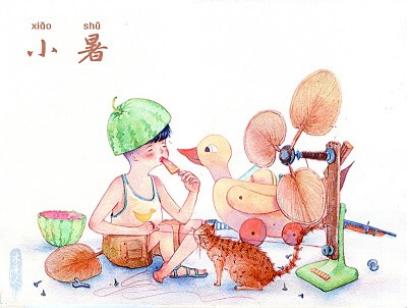 This solar term is characterized by hot and humid weather,which is reflected in the watercolour illustration created by Mukeren. In the painting, the mischievous boy who wears a “watermelon hat”, and the playful fan which is “easily-assembled” by hand, are combined with the other summer elements in an imaginative way.The refreshing colours of the illustration seem to instantly beat the summer heat. 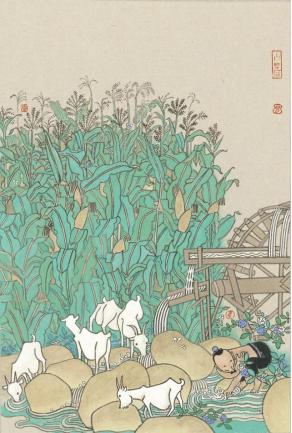 Another way to stay cool in the hot summer is to play in the water, which is depicted in the Chinese painting by Liu Jingui. The green cornfield which dominates the piece sets the mood for the painting.The lucid spring water flowing down from the waterwheel and then winding through the rocks, the man and the goats in different poses in the water, compose a scene which displays a good balance between stillness and motion. The large area of empty space adds a sense of coolness to the work. 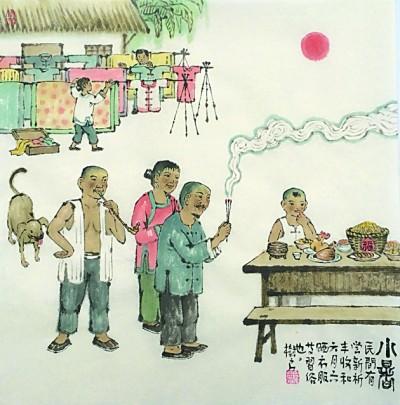 Apart from beating the heat, it is also important to make use of the heat during this solar term. Just as the saying goes, “During Xiaoshu, have the mould and damp removed”.People tend to dry their books, art works and clothing outdoors during Xiaoshu. This is shown in the painting by Dai Shuliang. In the distance, is the blazing sun, in which the bedding and clothes of various colours are neatly hung, a delightful scene filled with radiant hues of the hot summer days. The foreground of the painting features another custom of this solar term, tasting new rice. In the rural areas of China, farmers cook the newly-harvested rice and serve it as offerings to their ancestors and the God of Five Grains, before having a Xiaoshu feast. In the urban areas, people tend to buy new rice, which is cooked together with the old rice. With the little child who cannot resist the temptation of the delicious dishes on the table and the adults who burn incense to pray for a good harvest, this painting represents real life scenarios full of vigour and vitality. In addition, people also eat lotus roots, summer’s special congee, and rice field eel during this solar term. Xiaoshu, or Lesser Heat, is a stimulating prelude, continuously releasing heat and passion, leading us to the forthcoming climax of the hot summer symphony. |

| |||||||||||||